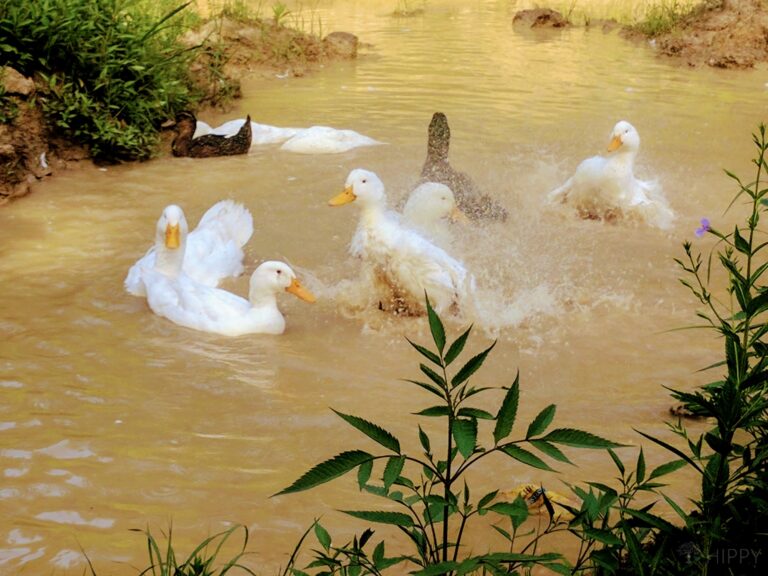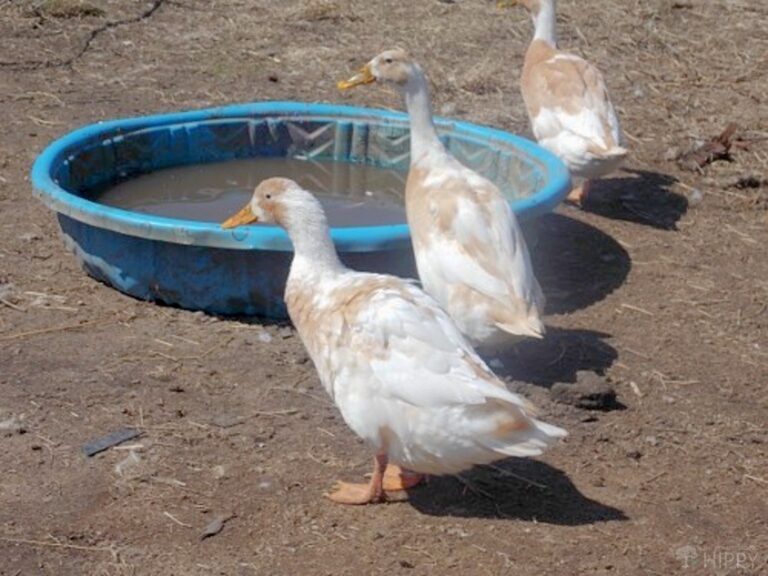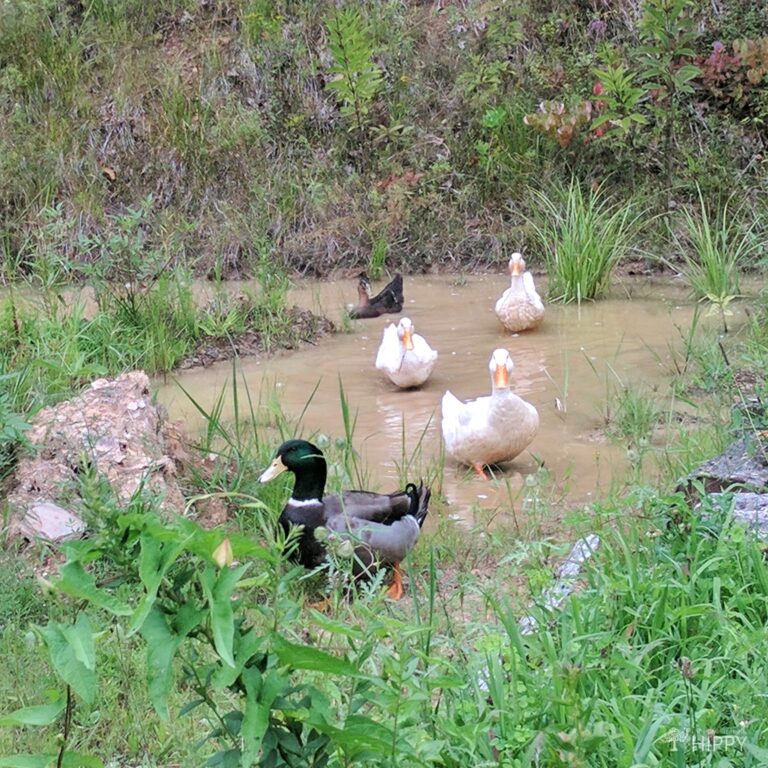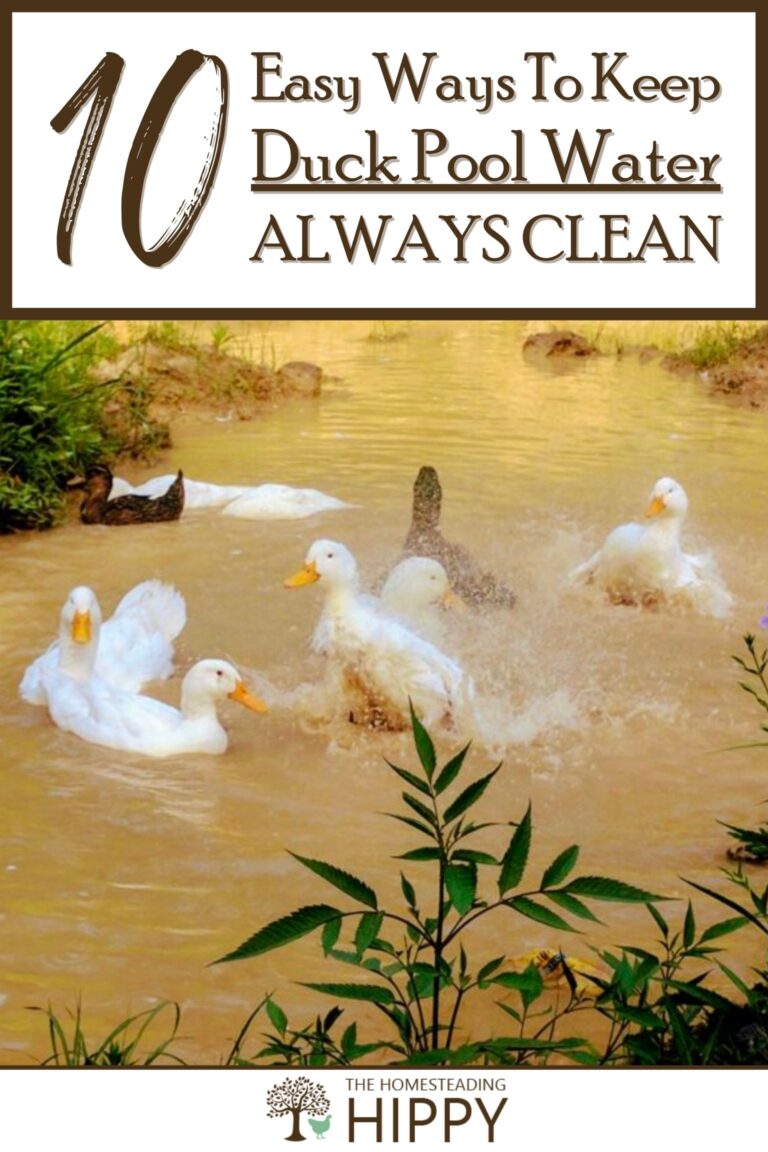If you’ve got ducks of your own, they probably have to have some kind of pool or pond in order to thrive. Ducks are waterfowl, and they spend quite a bit of time in the water.

More than this, they need water to get clean and also to help them eat much of the time.
But ducks, like all birds, poop a lot, and even if they don’t poop in the water, they’ll get it plenty dirty by bringing their food to it, or take a little dip to get clean.
In time, your duck pool can look like a toxic waste storage site! Aside from being unsightly and smelly, it is dangerous for your ducks and other animals.
There’s nothing to do except to keep it clean. If you don’t know how it can be a huge task or even a fruitless one.
Luckily I’m here to help you with 10 proven methods to keep both natural and man-made duck ponds safe and clean for your precious flock.
There are Two Kinds of Duck Pools: Man-Made and Natural
Before we get started, it’s important to make a distinction between the types of duck pools that are out there: man-made pools and natural ponds.
Both serve the same purpose for ducks, but the approach you’ll take to clean either of them is slightly different.
When it comes to man-made pools, they’re typically smaller than natural ponds, and the fact that they are lined or installed as a solid unit means you have different options for cleaning them out and sterilizing them to eliminate certain kinds of germs and other undesirable organisms.
Natural ponds, on the other hand, are generally too big for certain techniques like filtration, so you’ll need to take indirect methods to keep them clean enough for your ducks to inhabit them without getting sick.
Then again, there are methods that will work well for both. No matter which one you have, you can relax because there are plenty of techniques that I’ll tell you about for either.
With that said, let’s get on to our list…

Cleaning Options for Man-made Duck Pools
If you’ve got a man-made duck pool, the following methods will work well for you. Note that these methods generally don’t work for natural ponds for one reason or another, but they might if the pond is very small.
1. Filter the Water
Probably the most obvious method for cleaning and purifying a man-made duck pool is filtration.
Just like we filter an aquarium to keep the debris out of it for our fish, we can do the same thing for a duck pool that either has an in-ground liner or is made as a one-piece unit of solid material.
Basically, so long as the pond itself has no natural soil on the bottom, filtration is an option.
Filtration is highly effective if you have a large and powerful enough filter, and it’ll go a long way towards keeping the water clear and free from germs because the sediment and other contaminants that will build up over time will be removed.
However, this necessitates you maintaining the filter and cleaning or replacing it as necessary.
Depending on how many ducks you have and the size of the pool, this might be a frequent chore.
This can lead to substantial costs if you have to replace filters regularly, so make sure you perform a good assessment on your requirements before you invest.
Spending too little on a less capable filtration system will usually entail even higher maintenance and replacement costs on the back end.
2. Disinfect Water Regularly
Disinfection is a great way to vanquish germs and other microorganisms that will contaminate and make cloudy the water of your duck pool.
There are various chemicals used for this purpose, and one of the most well-known, affordable and useful is chlorine.
However, chlorine and all other chemicals have some significant downsides, namely the fact that they will hurt helpful organisms in the water right along with the harmful ones.
This can be harmful to your ducks especially if you add too much to the water. You generally don’t want to let your ducks get in or drink water from a pool that has been recently treated with chlorine.
Chlorine breaks down over time with exposure, and before too long, it’ll be safe for your ducks to enter once again.
Assuming you use a typical maintenance “dose” (check the package instructions for quantity) your ducks should be ready to reenter the pond with no worries within 48 hours, and likely less.
However, should take pains to keep them out of it until that time comes, which might be easier said than done depending on your circumstances.
3. Skim When Required
As mentioned, ducks poop in the water pretty much constantly, and along with dragging in dirt and dust from their bodies and food they like to dunk, pretty soon there will be all sorts of detritus floating on the surface of your duck pool.
One way to help keep the cleanliness of the pool intact longer is to skim it. Skimming will drag this debris out before it has a chance to break down in the water and to make a cloudy and dirty.
It also makes the pool look a lot nicer in a relatively short period of time.
You can use a traditional pool skimmer net or, potentially, a robot that is rated for dealing with more substantial debris.
Remember that the sooner and more often you skim, the nicer your pool will stay longer. You might also consider adding surfactants for the job.
Chemicals which will help dirt and debris float and stick together so it can be skimmed out easier.
4. Drain and Refill
This is the “nuclear option” for a man-made duck pool, but one that every owner that cares will eventually have to undertake.
Depending on the cost of water where you live and the size of the pool, this can be quite pricey.
Eventually, no matter what you do, the accumulated waste, dirt and other debris that makes its way into your pool will overcome all the other efforts to clean it. You’ll also need to drain it out, scrub it down, and refill it with fresh water.
For a smaller pool, any suitable submersible pump can do the job, or maybe even a Shop-Vac given enough time.
For larger duck pools, if you have the money you can invest in a permanently installed recycling system that can drain the water.
Obviously, make sure your ducks are not in the pond when you are draining it to prevent a horrible accident!

Cleaning Options for Natural Ponds
Cleaning a natural pond requires a different approach. For all but the smallest ponds, keeping the water clear, clean and germ-free is mostly a matter of establishing a genuine ecosystem in the pond.
The right combination of plants, fish, other aquatic life and aeration can prevent the growth of harmful organisms while keeping the water clear and actually giving your ducks some all-natural food sources.
It sounds really challenging, but with a little bit of homework, it isn’t too hard, and can make for a rewarding endeavor all by itself.
Note that all of the following methods can also be used to keep a man-made pool clean! You might have to work a little harder to establish fish and plants, and then you’ll have to lay off the chemicals, but it can be done.
1. Stock Pond with Fish
Fish can be a hugely important addition to a natural duck pond. Herbivorous species can eat plants that you don’t want in your pond, and also give your ducks something to eat.
Obviously, you only want to choose breeds that will reproduce quickly, so they can maintain numbers and ones that aren’t going to eat or hurt little ducklings!
Certain species of bluegill, catfish, tilapia and minnows are popular additions to duck ponds, and all are affordable and easy to get from certain farm and fish pond suppliers.
But before you add these fish willy-nilly, take the time to do some testing of your pond water and make sure it is suitable for their survival, otherwise you’re really going to have a mess to clean up!
2. Stock Pond with Other Aquatic Life
Fish are the first step in establishing an aquatic ecosystem, but not the last step. There are other aquatic creatures that are right at home in our natural duck pond.
These play an even more important role because they will actually eat and process the wastes that would otherwise build up in the pond, including duck poop!
Frogs, crayfish, mussels, snails, clams, and more will all help to keep algae at bay and prevent the buildup of toxic chemicals in the water that can hurt fish and plants and also eventually hurt your ducks.
And, as you might imagine, these scavenger creatures are another source of food for your ducks.
You might need to do a little bit more investigation to find a good source of these creatures if they aren’t already living in your area, and spend even more time doing homework on their own ecosystem requirements, but the sooner you add them the better.
3. Cultivate Aquatic Plants
The backbone of our naturally cleaned and filtered duck pond is aquatic plants. More than anything else, these plants will serve to filter and purify the water, and the leftover waste products from ducks.
All the other organisms in the pond will help to feed these plants, completing the circle of life.
But, before you stock your pond with aquatic plants it’s imperative that you research and figure out which ones are native to your area.
Generally, introducing non-native invasive species is a bad idea that can have serious long-term consequences for the surrounding area.
Duck-friendly options that are common and effective for helping to keep your pond clean or duckweed, cattails, pickerelweed, coontail, water lilies, smartweed, and water hyacinth.
Once these plants are established and healthy, and the rest of the ecosystem is in place, you should notice a gradual but discernible constant improvement in the clarity of the water and also in your test results for cleanliness.
4. Add Pond Microbes When Needed
Your ace-in-the-hole for jump-starting your little personal duck-based ecosystem is pond-friendly microbes, specifically those in the nitrosomonas and nitrobacter genuses.
These microbes are so helpful because they eat and convert the otherwise toxic ammonia found in duck poop into nitrates which are beneficial for plants in particular and some other organisms.
If this sounds overwhelmingly complicated, don’t worry about it: basically you’ll add these to your pond as a sort of all-natural pond chemical.
Even better, they are commonly available from most retailers that sell pond care and pool care supplies, and in certain gardening centers.
Just make sure you learn and understand how to conduct the testing necessary to determine when and how much of these microbes should be added to your pond.
5. Fight Algae with Barley Straw Products
Algae is an inescapable fact of pretty much any pond, no matter how stable and well cared for, but an overabundance of algae can disrupt and eventually collapse an entire pond ecosystem.
Accordingly, some of the work that goes into maintaining your natural duck pond will be in fighting off algae.
Remember that we don’t want to go with the harsh chemicals we use up above for a man-made pool! Instead, we use barley straw.
Barley straw, either in all-natural bundles or processed liquid extractive can be added to the pond periodically to help keep algae at bay without harming ducks or most other creatures in it.
Once again, this is something you can easily find online or at a local, well-stocked pond store.
6. Add a Sprayer or Bubbler System
Keeping the water in your pond oxygenated is critical. Aerobic (oxygen dependent) bacteria in the water that will help to break down waste products rely on oxygen to complete the process.
A lack of oxygen will lead to a bloom of anaerobic bacteria instead that can cause lots of the creatures in your pond to get sick or die- potentially including your ducks!
An easy way to keep the pond water oxygenated is through the use of a bubbler or sprayer system.
Pumping air directly into the pond (bubbler) or squirting the water into the air to fall back into the pond (sprayer) is generally adequate to keep it oxygenated.
How Often Should You Clean Your Duck Pond?
It depends. For a man-made duck pool, you’ll at least want to skim it and test it once a week, no less than that. More substantial cleaning can be done on an as-needed basis.
If you have a natural duck pond, once you have it properly set up, it should stay more or less clean all on its own!
That’s one of the benefits of getting plants, fish and other organisms established. However, you’ll still want to check it regularly and make sure the fish and plants are healthy, and those other little creatures are present.
Periodic testing should also be done to see if you need to add microbes or take action to reduce algae.
A quick inspection once a week is recommended, but an established pond probably won’t need your intervention more than once or twice a month for various factors.

Tom has built and remodeled homes, generated his own electricity, grown his own food and more, all in quest of remaining as independent of society as possible. Now he shares his experiences and hard-earned lessons with readers around the country.
Find out more about the team here.
